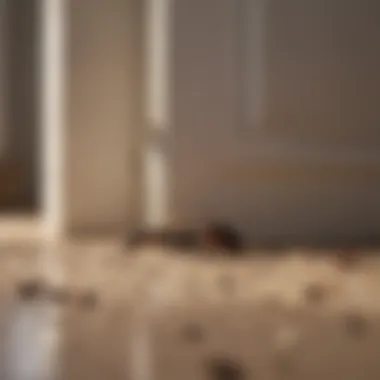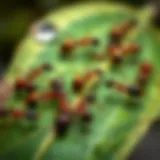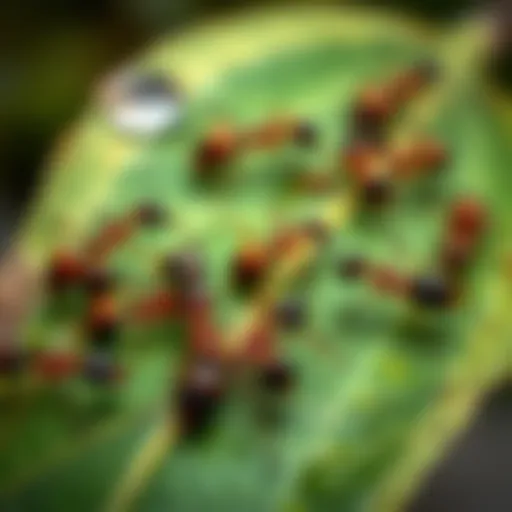Effective Strategies to Keep Ants Out of Your Home


Intro
This guide aims to equip homeowners with effective strategies to prevent ants from becoming unwelcome guests in their homes. Ants, while often overlooked, can cause serious disruption and even damage if not dealt with effectively. By gaining insight into their behavior and biology, one can not only mitigate the risk of infestation but also create an environment that discourages these resilient pests. Let’s dive into this detailed exploration.
Understanding the Pest
Getting a grasp on ants—who they are, how they live, and what makes them tick—is the first step in devising a practical plan to keep them at bay.
Identification
Knowing which ants are infringing on your territory is crucial. Some common species you might encounter include:
- Carpenter Ants: Known for hollowing out wood, they can threaten the structural integrity of your home.
- Sugar Ants: As their name suggests, they are attracted to sweet substances, making kitchens their prime target.
- Pavement Ants: Typically found outside, they can invade homes seeking warmth or food.
Taking note of their tiny size and distinctive markings can aid in identifying the specific types roaming around.
Life Cycle
Ants have a fascinating life cycle that consists of four stages: eggs, larvae, pupae, and adults. Each stage plays a critical role in maintaining the colony's population.
- Eggs are typically laid by the queen. Once they hatch into larvae, they are fed by worker ants.
- After maturing from larvae into pupae, they will eventually emerge as adult ants.
Understanding this cycle can highlight why ants invade homes: they are always on the hunt for new food and shelter to fuel their persistent life cycle.
Pest Prevention Strategies
Effective prevention is often simpler than extermination, especially if one takes proactive measures early on.
Environment Modification
Creating a less inviting home for ants can significantly reduce the chances of an infestation:
- Seal Entry Points: Look for cracks and gaps around doors, windows, and foundations. Using caulk, you can prevent ants from sneaking in.
- Maintain Cleanliness: Ensure food is stored properly and floors are free from spills and crumbs. Don’t leave pet food out overnight.
- Manage Moisture: Fix leaky faucets and pipes, as ants are often drawn to damp areas.
Physical Barriers
Implementing barriers can add an extra layer of protection:
- Ant Baits: Placing bait stations can attract ants, leading them away from your living space and directly into traps.
- Natural Deterrents: Sprinkling diatomaceous earth in areas prone to ant activity can deter them. This natural powder is harmless to pets but lethal to ants.
Control Methods
Sometimes, despite best efforts, an infestation may occur. Knowing your control options is essential for tackling ants effectively.
Chemical Control
Chemical methods can be effective but should be approached with caution.
- Insecticides: There are numerous ant-specific insecticides available that can eliminate colonies. Products like Ortho® Home Defense or Raid® Ant Killer are commonly used. Always follow instructions to ensure safety for your household.
Biological Control
For those seeking a more environmentally friendly approach, biological control can be a viable option:
- Beneficial Nematodes: These tiny roundworms can be introduced into the soil around your home to target ant larvae. They offer a non-toxic alternative to traditional pesticides.
"By understanding the biology and habits of ants, homeowners can develop effective strategies that yield favorable results in keeping their spaces ant-free."
Understanding Ant Behavior
Understanding the behavior of ants is paramount when it comes to keeping them out of your home. Ants are not just pesky intruders; they have a complex social structure, intricate communication methods, and specific biological traits that dictate their actions. By taking the time to comprehend how these miniature creatures operate, homeowners can strategize effectively, creating an environment that is less inviting to them.
Getting familiar with the biological traits of ants can arm you with the knowledge to disrupt their usual activities. For example, recognizing their foraging patterns can help in identifying potential attractants and in setting up barriers to deter them. Such proactive measures are more effective when aligned with their natural tendencies, thus making it significantly harder for ants to invade.
Moreover, understanding the social structure of ants is crucial. These little creatures work as a cohesive unit, which means that if one or several scout ants find food, they'll communicate this to their comrades, leading to a full-scale invasion. Recognizing this pattern can help you nip the problem in the bud before it escalates.
In summary, grasping ant behavior provides home and property owners not only with insight into how to deter them but also with a lens through which they can understand the full scope of ant infestations.
The Biology of Ants


The biology of ants is fascinating and integral to understanding why they invade homes. Ants are part of the order Hymenoptera, which makes them relatives of bees and wasps. Each species exhibits unique traits, but some commonalities make up their biological framework.
Ants have a three-part body structure: head, thorax, and abdomen. The head houses the mandibles, used for gripping and carrying food, while antennae serve as vital sensory organs. The thorax is where legs are attached, enabling them to traverse their environment efficiently. Their abdomen contains the digestive system and reproductive organs, which play important roles in colony sustainability.
Ants are known for their extraordinary strength; they can lift objects many times their weight. This attribute is particularly useful when they transport food back to their nests. Understanding these biological functions is essential when considering how to prevent them from becoming unwelcome guests.
Common Species Invading Homes
In many regions, several species of ants have earned a notorious reputation for invading homes. Some of the most common include:
- Argentine Ants: They create extensive colonies and can be found in large numbers, particularly in kitchens.
- Carpenter Ants: Known for nesting in wood; they can damage structural elements of a home if left unchecked.
- Odorous House Ants: They make their presence known by emitting a distinct odor when crushed, making them easily identifiable.
- Pavement Ants: Typically found in cracks of pavement, they're frequent visitors to homes in search of food.
Identifying which species are in your area can greatly enhance your strategies to keep them at bay. Each type has varied habits and preferences, influencing how you may approach prevention.
Ant Communication and Nesting Habits
Ants communicate primarily through pheromones, which are chemical signals they leave behind. These signals help alert other ants of food sources and dangers. When you see ants walking in a line, they are likely following a pheromone trail laid by another ant. This inherently social nature means that if you can disrupt or eliminate these trails, you can effectively break the cycle of raids into your pantry.
In terms of nesting, ants can establish their colonies in numerous locations, often within walls, under sinks, or buried deep within gardens. Some species are especially fond of moisture, which can direct them towards leaky pipes or damp areas in the home. Knowing where these nests can be typically found helps in planning a comprehensive anti-ant strategy.
An ounce of prevention is worth a pound of cure. Understanding ant behavior leads to more effective methods in keeping your residence pest-free.
Identifying Ant Attractants
The first step in keeping ants out of your home is understanding what exactly draws them in. Recognizing the elements that attract these pests is essential for effective pest management. By addressing these attractants, homeowners can significantly reduce the likelihood of an infestation, making it easier to maintain a pest-free environment. Moreover, knowing the common triggers fosters better cleaning habits and encourages preventive measures that can be easily integrated into daily routines.
Food Sources That Attract Ants
Ants are often drawn to a variety of food sources, and being aware of these can help eliminate unwanted guests. These little critters have an impressive sense of smell and can detect food even in minute amounts. Common food items that entice ants include:
- Sugary substances: Spills of juice or soda, honey, and even some fruits are at the top of their attraction list.
- Greasy or fatty foods: Crumbs from snacks, leftover pizza, or even pet food can provide ants with the nutrients they crave.
- Bread and baked goods: The carbohydrates in bread make it a favorite, often leading them straight to the pantry.
To prevent ants from having a field day in your kitchen, it's imperative to keep food sealed tightly in airtight containers. Cleanup after meals should not be overlooked; ensuring all crumbs are swept away and surfaces are wiped down reduces food accessibility for ants.
Environmental Factors Contributing to Infestations
It's not just food that attracts ants—environmental factors also play a significant role in enticing them indoors. For instance, a warm, damp, and clutter-free environment can be an open invitation. Here are some key elements:
- Moisture presence: Any leaks from pipes or excess humidity in the home can attract ants seeking water, particularly during dry spells outside.
- Outdoor vegetation: Overgrown shrubs and plants near your home can act as highways for ants, directing them right to your doorstep.
- Debris and clutter: Piles of leaves, wood, or trash around your home provide shelter and nesting spots for ants, making it a prime locale.
To combat these issues, regular inspections of your environment should be a priority. Keep your landscaping tidy by trimming back any overgrown plants, and ensure there are no accumulated debris that could foster their comfortable stay.
Common Entry Points for Ants
Understanding how ants gain access to your home is vital in preventing future invasions. Here are some common entry points to keep an eye on:
- Cracks in walls and foundations: Small imperfections can serve as gateways for ants. Even tiny openings should be sealed to thwart their entry.
- Gaps around windows and doors: Check the seals around these areas—this is often where they make their first appearance.
- Vents and drains: Often overlooked, these areas can give ants direct access to your living spaces.
To address these potential entry points, consider employing caulking or foam sealants around cracks and crevices—an easy yet effective way to keep ants at bay.
Keeping your home clean and sealed up tight is half the battle against ants.
Paying close attention to these attractants can empower homeowners to take proactive measures. With sufficient understanding, you can eliminate the lure of food, reduce environmental hazards, and seal off potential entry points—all crucial steps in the battle against ant infestations.
Preventive Measures
Preventive measures are crucial in the fight against ants invading your home. A proactive approach helps you avoid the hassle of an infestation. By sealing cracks, properly storing food, and making sensible landscaping choices, you’re addressing the root causes of why ants venture inside. These measures not only deter ants but also promote a clean and organized living environment. Let's break down some specific strategies that can significantly reduce the likelihood of ants calling your house home.
Sealing Entry Points
Door Seals and Weather Stripping
The importance of door seals and weather stripping cannot be overstated. These components serve as the first line of defense against ants looking for a way inside. They help create a barrier, thwarting ants that try to sneak in through gaps at the bottom of doors. A key characteristic of this approach is the relatively low cost and ease of installation. Using self-adhesive compression strips or metal sweeps not only gives better insulation during seasons but also fortifies your home against pests.
Consider that ants can squeeze through spaces as thin as a credit card. Thus, ensuring a snug fit will often spell success in pest-proofing your entryways. While it’s a popular and effective strategy, homeowners must remember to replace worn-out materials timely to maintain efficiency.
Window Screens and Sealing Cracks
Window screens and sealing cracks fulfill a similar role as door seals. Cracked or loose window screens can provide ants a direct gateway into your home. Ensuring that your screens are in good repair is not only beneficial for keeping insects out but also helps improve air flow when opened. The unique feature of applying caulk or expanding foam to fill in cracks can really make a difference. This becomes a barrier that prevents ants from finding tiny harborage spots around windows, where they can easily access your living area. But the downside? It often requires a little maintenance and inspections over time to catch wear and tear early.
Proper Food Storage Techniques
Airtight Containers


Using airtight containers is one of the simplest yet impactful techniques for preventing ant attraction. These containers create an impenetrable environment that can dissuade ants from sniffing out their next meal in your pantry. A notable characteristic is the variety of materials available, including plastic, glass, and metal. Choosing the right one involves considering longevity and ease of access for household use. When done right, food stays fresher longer while also safeguarding against pests. However, while airtight containers are an excellent choice, they should ideally be complemented by diligent cleaning to eliminate crumbs and spills.
Routine Cleaning Practices
Routine cleaning practices form another essential aspect of maintaining a pest-free environment at home. Cleaning methods such as sweeping, mopping, and vacuuming help eliminate crumbs that can attract ants. The key characteristic of maintaining a consistent cleaning schedule is that it becomes ingrained as a habit. Not only does it keep ants at bay, but it also promotes a healthier living space overall.
The unique feature of implementing a system of daily tidying paired with deeper weekly cleanings can act as a strong deterrent. One small drawback is the time commitment required, but investing time can yield significant rewards in ant prevention.
Landscaping Changes to Reduce Attraction
Removing Debris and Clutter
One straightforward strategy for keeping ants away is simply removing debris and clutter from around your property. This includes piles of leaves, wood, or any other organic material that can serve as a nesting ground for ants. A major characteristic of this approach is its immediate visibility; a tidy yard often produces a sense of order and points to a well-maintained home. By creating physical barriers and eliminating hiding spaces, you mitigate the chances of ants finding a comfortable place to thrive. But take care—sometimes, the cleanup effort may seem overwhelming, depending on how cluttered the yard is.
Strategic Planting Choices
Making thoughtful choices about landscaping and planting can also deter ants. For example, using plants that naturally repel ants—like mint or rosemary—can create a simpler, more organic pest control strategy. The unique feature of these plants is their dual purpose; they not only beautify your garden but also contribute to a less inviting environment for pests. This method becomes a beneficial choice by promoting biodiversity in your garden while creating a dissuasive atmosphere. Yet, one must be mindful of specific growth needs and management of these plants to avoid unintended consequences.
Natural Deterrents
Natural deterrents play a vital role in keeping ants at bay, offering eco-friendly solutions that homeowners can swiftly implement. These methods stand out for their safety, affordability, and effectiveness. While chemical pesticides can raise eyebrows due to their potential harm to health and the environment, natural alternatives work subtly and make the home less inviting for unwanted guests. Exploring these options helps build a strong foundation for an ant-free home, allowing residents to feel at ease and live harmoniously.
Essential Oils as Repellents
Peppermint Oil
Peppermint oil has become a popular choice due to its strong scent that ants find utterly unappealing. Ants rely heavily on scent for navigation and communication, making peppermint oil a natural disruptor of their pathways. Not only does it mask their scent trails, but its potency also repels them effectively. Furthermore, this oil is simple to use; just mix a few drops with water in a spray bottle and apply it to entry points or areas where ants tend to gather.
One of the outstanding characteristics of peppermint oil is its refreshing smell, which can double as a pleasant home fragrance without any harsh chemicals. However, some may find the aroma a bit too strong. Despite this minor setback, peppermint oil has gained traction in households looking for a green approach.
- Advantages:
- Disadvantages:
- Natural and safe for indoor use
- Strong peppermint scent deters ants
- Scent may be too overpowering for some people's tastes
Lemon Oil
Lemon oil, like its peppermint counterpart, carries a unique feature that enhances its effectiveness against ants. The citric aroma not only provides a fresh scent but also acts as a deterrent for many species of ants. By disrupting their ability to communicate, lemon oil can turn your home into an unwelcome environment. A simple solution is mixing lemon oil with water and spraying it around possible entry points.
Another attractive quality of lemon oil is its ability to clean surfaces while repelling pests. This includes dirt and grease, which, if left unchecked, might lure in ants looking for easy food sources. Nonetheless, it’s crucial to ensure that any surface treated with lemon oil is safe for the mixture, as some materials may react unfavorably.
- Advantages:
- Disadvantages:
- Acts as a natural cleaner while deterring ants
- Fresh citrus scent is pleasant in the home
- Effects may diminish quickly in outdoor conditions
Vinegar and Water Solutions
Vinegar mixed with water serves as a classic remedy in the ongoing battle against ants. When used as a cleaning solution, it not only cleans surfaces but also wipes out ant scent trails, making it an effective barrier against future invasions. The acidic nature of vinegar helps disrupt ant pheromone trails, which ants rely on to navigate efficiently. Applying a simple spray of equal parts vinegar and water around known entry points can deter them effectively and create a less friendly atmosphere.
In addition to its repelling properties, vinegar is incredibly cheap and often found in most households. However, individuals should keep in mind that while vinegar can deter ants, it may not offer long-lasting results, especially against larger infestations.
Diatomaceous Earth Applications
Diatomaceous earth is often hailed as a wonder material for pest control. This powdered substance, made from fossilized algae, works particularly well against ants and other crawling insects. When ants come into contact with it, the powder clings to their bodies and eventually dehydrates them.
The key feature of diatomaceous earth lies in its non-toxic nature, making it safe for children and pets. Its ability to disrupt the physical structure of the insects is what sets it apart from traditional pesticides. However, it's essential to apply it carefully; it should be kept dry for maximum effectiveness.
Using diatomaceous earth also requires some monitoring during application, as it can also affect beneficial insects in the ecosystem. Nevertheless, for homeowners seeking a natural method to combat ants without resorting to chemicals, this method proves both effective and relatively easy to implement.
Professional Pest Control Solutions
When dealing with ants in your home, knowing when to call in the pros can be crucial. While some infestations might seem manageable on your own, others may require specialized knowledge and tools that professionals possess. Among the benefits of hiring pest control services are their ability to identify the specific species of ants, which often determine the best course of action for eradication. Additionally, pest control experts can offer eco-friendly solutions, ensuring that your home remains safe for both family and pets.
When to Seek Professional Help
There are certain indicators that signal the time has come to seek professional help. If you notice an increasing trail of ants that seem to appear out of nowhere, or if you're unable to locate where they are nesting, it’s almost a sure sign you've got a bigger problem on your hands. For example, carpenter ants can cause significant structural damage if left untreated and may be tunneling into wall spaces, which is not easily noticeable. These signs, coupled with your attempts to control them failing, call for a more serious approach.
Common Pest Control Techniques Used


Baiting Systems
Baiting systems present a unique method of dealing with pests, particularly useful for controlling ant populations. At its core, baiting involves placing a lure that is enticing for the target ants. This bait is usually mixed with a slow-acting insecticide. What sets baiting systems apart is their way of effectively reaching the hidden colonies. Ants take the poison back to their nest, where it can affect other ants, including the queen. This indirect approach can often eliminate entire colonies where traditional spray methods might fail.
The appeal of baiting systems lies in their non-intrusive nature. Homeowners can place baits in areas where they see ant activity without disrupting their daily routines. However, it’s important to note that patience is required; results can take days or even weeks to show, as it relies on ants sharing the bait within their colonies. Nevertheless, the lasting effects often prove beneficial for long-term ant control strategies.
Barrier Treatments
Barrier treatments are another effective technique in pest control. This involves creating an invisible shield around your home that deters ants from crossing. This method usually uses a pesticide treated along the foundation or entry points, preventing ants from entering your space altogether. The key characteristic here is their preventative nature; rather than waiting for an infestation, these treatments proactively stop pests before they can cause issues.
The unique feature of barrier treatments is their longevity. They can remain effective for several months, depending on environmental conditions. One downside, however, is the potential concerns some might have regarding chemical exposure in their homes and outdoor spaces. Therefore, it's always wise to discuss with the pest control service about their choice of pesticides and if there are eco-friendly alternatives available.
Evaluating Pest Control Services
Choosing the right pest control service is as pivotal as the techniques they employ. Factors to consider include their reputation, service range, and the methods they employ. Recommendations from friends or family can bolster your confidence in a service, but reviews online also provide insights. Understanding their approach to pest management—whether they use integrated pest management techniques or focus solely on chemical solutions—can help you align their methods with your values regarding safety and environmental impact.
Ultimately, a reliable pest control service will offer you a meticulous evaluation of your home and advise on the best course of action tailored to your situation.
It's essential to weigh your options carefully; a proactive approach can save you from major headaches later on.
Long-Term Maintenance Strategies
In the ongoing battle against ants, implementing long-term maintenance strategies is essential for fortifying your home’s defenses. Maintaining an ant-free residence isn't just about reacting when you see a few of them marching across the kitchen counter. It’s about developing a consistent plan that helps you stay ahead of the curve and avoid infestations altogether. A proactive approach reflects on the health of your living environment and the comfort it brings to you and your family.
Regular Inspections and Monitoring
Regularly inspecting your property plays a pivotal role in preventing ant invasions. By keeping an eye out for the telltale signs of ants, such as small piles of dirt near possible entry points or trail marks leading to food sources, you can address issues before they escalate. The process doesn’t require an PhD in entomology; homeowners should familiarize themselves with common ant behaviors and entry patterns.
Here are some key points to consider during inspections:
- Check foundations, doorways, and windows for cracks and tiny openings.
- Look inside storage spaces, particularly where food is kept. Even a forgotten crumb can lead to a gathering of hungry ants.
- Inspect landscaping: Ants often nest in outdoor plant beds, so understanding your garden’s setup can help.
Monitoring these areas regularly helps to ensure you are catching any culprits before they wreak havoc inside your home. If you uncover issues during your checks, you can implement corrective actions immediately, thus saving your home from a full-blown infestation.
Adapting Strategies Seasonally
Just as you would adjust your wardrobe for the changing seasons, your ant prevention strategies require similar adaptation to changing environmental conditions. Different times of the year can draw out different ant species, each with their specific behaviors and habits that you need to recognize and respond to accordingly.
For instance, during the spring, ants are especially active as they forage for food to sustain their colonies. To effectively manage this:
- Increase vigilance around food storage areas as the weather warms.
- Ensure that entry points are sealed tight, preventing those eager scouts from making it inside.
Come fall, many householders might inadvertently offer a warm welcome to ants seeking shelter from the cold. Rethink your outdoor landscapes by clearing debris and other potential nesting spots as winter approaches. Being mindful of these seasonal shifts aids in tailoring your strategies appropriately, ensuring a fortified approach year-round.
Community Awareness and Collaboration
An often-overlooked aspect of long-term strategies for keeping ants at bay is the level of community awareness and collaboration. It’s not just your home that needs to be safeguarded; the neighborhoods around you can also influence the behavior of ant populations.
Engaging with neighbors helps in several ways:
- Sharing knowledge: Discuss common ant species and their habits. What might work for one person in a geographical zone could be useful knowledge for others.
- Coordinated efforts: If an infestation is widespread in your neighborhood, rallying efforts to handle it collectively could prove more beneficial than individual approaches.
- Community cleanliness initiatives: Encourage regular disposal of garbage and debris to keep areas clean and less attractive to ants.
By fostering a sense of shared responsibility regarding pest control, you’ll not only enhance the quality of your living environment but also strengthen the community's reputation as a place where pests are effectively managed. Together, homeowners can build a fortified barrier against ants that is far more resilient than any individual effort could provide.
Ultimately, a thorough understanding of the importance of long-term strategies, combined with regular monitoring, seasonal adjustments, and community engagement, creates a fortress against unwanted guests in your home.
Maintaining this habit makes the difference between a one-time nuisance and an ongoing headache.
Ending
Understanding how to keep ants out of your home is crucial for maintaining a comfortable living environment. Ants, while small, can quickly become a significant nuisance, invading kitchens, pantries, and other areas where food is stored. By addressing the attractants, sealing entry points, and employing both natural and professional deterrents, homeowners can effectively manage ant populations around their property.
Summarizing Effective Practices
To encapsulate the best practices for thwarting ant infestations:
- Identify and Remove Food Sources: Keeping your home clean, especially in the kitchen, is non-negotiable. Wipe countertops regularly and store all food in airtight containers to avoid inviting these pests.
- Seal Entry Points: Conduct a thorough inspection of your home and seal any cracks or gaps found in walls, windows, and doors. Pay close attention to where plumbing and electrical lines enter the house.
- Employ Natural Deterrents: Utilizing essential oils like peppermint or vinegar solutions can keep ants at bay without the need for harsh chemicals. These substances are not only potent but also safer for families and pets.
- Seek Professional Help if Needed: If the infestation persists despite your efforts, it may be time to consult pest control experts who can provide advanced solutions and techniques tailored to your situation.
This multilayered approach allows homeowners to be proactive rather than reactive to ant invasions, leading to better results in a shorter amount of time.
Encouraging Sustainable Practices
Sustainability in pest management is vital, not just for the well-being of the environment but also for the future of effective home maintenance. Here are some sustainable practices to consider:
- Opt for Natural Deterrents: As previously mentioned, natural ingredients can effectively repel ants. This means limiting the use of synthetic pesticides, which often have adverse effects on the ecosystem.
- Educate the Household: Share knowledge about the importance of cleanliness and maintenance of outdoor spaces. Small changes in everyday habits by family members can significantly impact ant attractants.
- Participate in Community Initiatives: Engage with neighbors to discuss pest management strategies. Often, an infestation in one home can affect many in the community, so collective efforts can yield greater success.
- Awareness of Native Species: Understanding your local ant species can help in creating targeted strategies. For instance, knowing whether you are dealing with carpenter ants versus sugar ants can shape your tactics.
By integrating these sustainable measures into your pest management routine, you contribute to a healthier environment while keeping your home free of unwanted ant guests. The intersection of effective practices and sustainability presents homeowners a pathway to long-term pest control success.







